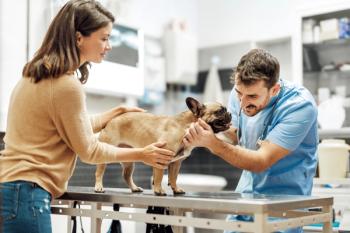
Fees: It's all in the presentation
Turn common sense on its head: Present your fee schedule to pet-owning clients-personally
I find it amazing how far we'll go go to avoid anything personally distasteful. Should a restaurant server bring me a dinner with broccoli on the plate, you can bet the farm that it will go back to the kitchen as unacceptable. I don't even want the same plate once the broccoli has been there. I believe that every menu should have a caution statement if broccoli is going to be involved.
Fees, in any veterinary hospital, present the same kind of problems to most practitioners. We hate them! We want to serve our patients without the least mention of fees. I went through four years of veterinary curriculum without hearing the word "fees." Students never knew who handled the financial side of the university veterinary clinic. It was a well-guarded academic secret.
I guess I was lucky in that I had worked a few summers in a local clinic and occasionally saw what needed to be paid for. Of course, at that time an office visit was only $5 and a case of 24 cans of veterinarian-recommended food was $8. Did clients complain about those fees? You betcha! Mostly because a good cup of coffee was still a nickel and a carton (10 packs) of cigarettes was $2.
Now that we've established that I'm old, let me share some of my wisdom that came with age: Fees don't mean a thing unless your client accepts them.
Hold your head up high
Even today, in the age of untold numbers of psychological studies on numbers and fees, the No. 1 reason a veterinarian charges X dollars for Y procedure is that he or she just continued the same fees of the previous owner. This is certainly a case of "dumb and dumber." The seller was flying by the seat of his/her pants, and the buyer swallowed that nonsense.
Today's fees are derived from specific overhead costs modified by average family income, local area growth rates, per capita pet spending and discretionary income. Local demographics determine whether high-quality medical procedures will be accepted.
Consulting in London years ago, I asked for the surgical fee schedule: 300 pounds, the equivalent of $850 today.
"For what procedure?" I asked.
The veterinarian replied that he wouldn't even start a surgery for less. That attitude worked for him then and still does today with all of the economic woes the UK is going through.
About the same time, an Arizona veterinarian called to ask if I thought it would be all right to charge $50 for injections. I asked him what he charged now, and he replied $45. He had been charging that same $45 for 10 years and thought it was about time for an increase.
I agreed, despite the fact that the average practice was charging $12 to $15 at the time. If his clients thought it was worth $45, a meager $5 increase after 10 years was going to be perfectly agreeable.
Attitude. That's what it's about. Either your services are worth paying well for—or they're not.
Show your stuff
Now let's discuss presentation. In 32 years studying demographics and fair fees, my consulting firm has created more than 90,000 30-page customized fee schedules. Does that make me an expert? No, but I know that most veterinarians do not use their fee schedules properly. They shoot themselves in the foot almost every time they hand the client a preprinted estimate for what their pet needs. The problem starts after you tell a client that a pet needs a surgical treatment, and they ask, "What's it going to cost, Doc?"
The last thing your client wants is a computer printout estimate. That's as bad as a phone call to your clinic answered with a "Dial one for our hours." Clients want the human touch here.
Looking up fees on a 30-page schedule tells clients that you're into medicine first, and you don't keep fees in your head. (That's true enough.) The client also sees that the fees are the same for everyone.
Walk through the fees
Here's the script: Open your drawer, and pull out the spiralbound fee schedule you put in every exam room as well as treatment and reception. Open it. "Let's see here," you say. "We absolutely can't do anything without the lab telling us his strengths and weaknesses before anesthesia." Then you write down the numbers on a form as you turn the pages and "discover" them.
"The standard pre-op lab profile is $159.20. The anesthesia I'll estimate at just over an hour at $184.70. The surgical procedure will take just about an hour and cost about $480. Monitoring and prep will be $37. We're going to need two to three days for hospital recovery, so that's $150. I can't predict what medicine he'll need after surgery, so I would be prepared for somewhere in the neighborhood of—let me add this up—about $1,200 to $1,500 to get him back home where he belongs. It's a good thing he has a family that loves him as much as you do to go home to.
"Let's get the lab sent out and start on his surgical prep. I've scheduled him for tomorrow morning, and I'll have a better picture from the lab results by then."
You won't get the same level of compliance with your recommended care from a computer printout delivered by a technician. The step-by-step process above works better.
If the client says, "I can't afford that!" you respond, "What do you mean by that?"
The client could then say, "I don't get my check until Friday" or "That's too much for me at one time." That's when you let them know about all the great credit plans you have. After all, it's not the total that counts, it's the terms. You can afford a $10 million home if it's on a 50-year mortgage at $2,000 a month.
Fee schedules shouldn't be guesswork. You never had to use one in veterinary college? What a waste! That's just as important to know as the dosage of the drugs we use.
Dr. Snyder, a well-known consultant, publishes Veterinary Productivity, a newsletter for practice productivity. He can be reached at 112 Harmon Cove Towers Secaucus, NJ 07094; (800) 292-7995;
Newsletter
From exam room tips to practice management insights, get trusted veterinary news delivered straight to your inbox—subscribe to dvm360.






